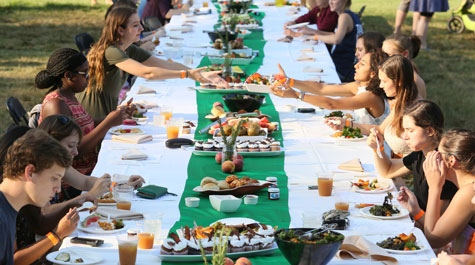W&M announces new, long-range Sustainability Plan
William & Mary President Katherine A. Rowe today announced the adoption of the university’s first long-range, comprehensive Sustainability Plan.
As part of the plan, the university has signed onto the Sustainable Endowments Institute’s Billion Dollar Green Challenge, pledging to grow its green revolving fund for environmental efforts from $200,000 to $1 million by 2025. W&M is the first public institution in Virginia to join the challenge.
“William & Mary’s 325-year history of exceptional academics, civic engagement and innovation equip the university to meet the challenges of a sustainable future,” Rowe said. “As an institution that prepares students to be global citizens, we view our campus as a lab for generating innovative solutions to the many challenges confronting the world today – be they environmental, social, individual or economic. This plan articulates that vision.”
With a combination of cost-reducing elements and efforts that will cost money, W&M plans to invest in sustainability because of its overarching importance for the future of the university and the world, according to officials.
William & Mary’s green revolving fund, the Green to Gold Fund, is a powerful tool to help the university reduce environmental impacts and combat climate change, according to Director of Sustainability Calandra Waters Lake. The fund provides loans to W&M departments and offices for projects that reduce greenhouse gas emissions and/or resource use, with some of the savings paid back into the fund to be used for other projects. The pilot project for the Green to Gold Fund was an LED lighting retrofit for the parking deck on Ukrop Way in 2016 that cost $80,000 but saves $17,000 per year in utility expenses and bulb replacements.
Signing on to the Billion Dollar Green Challenge to increase the fund, which was a decision made by President Rowe and will be funded with private dollars received from donors, will allow for more impacts across campus through additional projects. The goal of the challenge is for colleges, universities and other nonprofit institutions to invest a combined total of $1 billion dollars in self-managed green revolving funds. The SEI launched the challenge in 2011 to help nonprofit institutions achieve sizable energy savings through the use of green revolving funds.
"Projects financed through our Green to Gold Fund demonstrate that reducing carbon and reducing costs are not competing priorities. We can accomplish both, especially when we have sufficient seed money." said Vice President for Strategic Initiatives & Public Affairs Henry Broaddus, who chairs the Green to Gold Fund committee. "Being part of the Billion Dollar Green Challenge gives us greater ability to share best practices with others who manage similar funds and to improve what we are doing here at William & Mary."
Other components of the W&M Sustainability Plan include a commitment to creating a climate action plan by 2020, which will include establishing a date for carbon neutrality and exploring renewable energy for the campus. Individual departmental efforts are wide-ranging from elimination of single-use plastics distribution at Commons and the Sadler Center by dining services to the implementation of electric vehicle charging stations by transportation.
Departments and offices all over the campus contributed to the plan, which isn’t limited to environmental efforts such as recycling and energy savings. There are components covering areas such as diversity and wellness as well. The plan will demonstrate W&M’s vision for sustainability over the next five years and serve as an example of initiatives people can get involved with or contribute toward.
“The scope of the plan demonstrates how we are connected: It’s complicated. People are complicated. The environment’s complicated,” Waters Lake said. “Looking at the big picture and working together, that’s how we make progress.”
William & Mary’s original Sustainability Plan established its Committee on Sustainability in 2008 and was project-based. Among its components is the student Green Fee, which funds a variety of research, initiatives and projects. The university started the Green to Gold Fund in 2016 with $200,000 from student Green Fee revenue.
In their introductory letter to the Sustainability Plan, Committee on Sustainability Co-Chairs Lynda Butler, Chancellor Professor of Law, and John Swaddle, Professor of Biology, write that the student-led movement to establish the Green Fee "led to the formation of our committee and a proliferation of projects that have reduced carbon footprints, increased energy efficiency, resulted in new teaching and learning opportunities, reduced waste and increased recycling and reuse, helped to infuse dining services with sustainable practices, and even on occasion has saved the university money. The plan described in this document honors the intent of those founding students while also proposing a step-change in how William & Mary addresses issues of sustainability, broadly conceived."
 Skip to main content
Skip to main content

